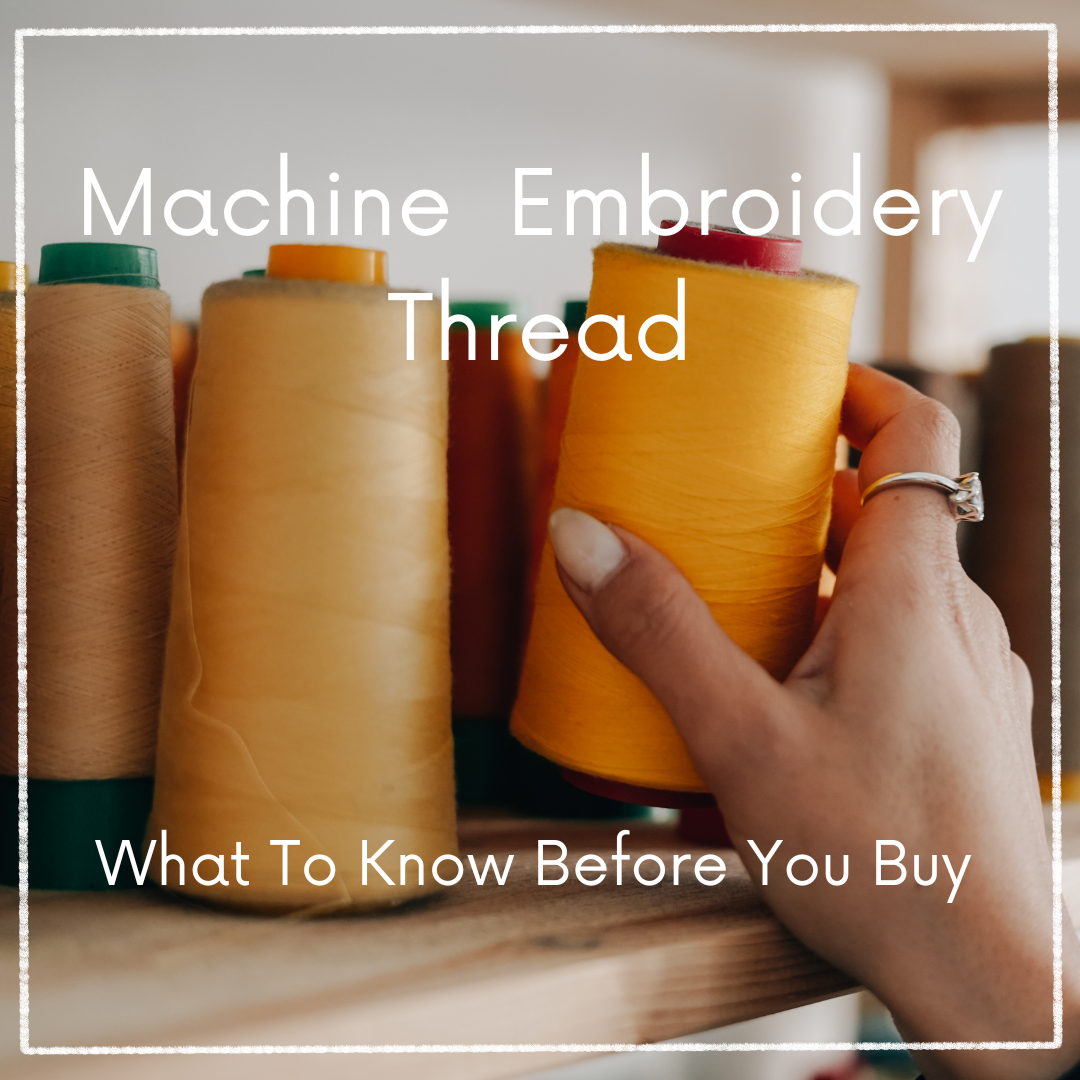When I bought my first embroidery machine, I couldn't wait to try it out. I unpacked my machine and drove to the nearest fabric store that I knew sold machine embroidery thread. I didn't even know about the different kinds of threads out there.
Fast forward a few years, I now have a lot more knowledge and experience buying and using machine embroidery threads.
Today I have a few handy tips for you that you can keep in mind, next time you are choosing embroidery threads for your embroidery machine so that you don't have to make the mistakes I did.
I know you don't want to spend thousands of dollars on loads of different machine embroidery threads, and by making a few informed choices, you can buy a few machine embroidery threads that will be suitable for a variety of projects.
Although it can be overwhelming to choose the best thread for your embroidery machine and project at hand, especially if you are new to embroidery, there are a few basics to keep in mind when buying machine embroidery thread.
You may be wondering which embroidery threads are best to use with which fabrics and machine needles. If you had a few mishaps on your machine, you are probably wondering what the culprit is causing the problems, and yes, it may be your machine embroidery thread. If your machine embroidery thread breaks often, cause crows nests, tangles, causes tension problems, and just doesn't look good, chances are you are using the wrong machine embroidery thread.
With all the machine embroidery thread choices out there, it's sometimes hard to know which embroidery thread to use and for what purpose. Don't be overwhelmed or quit machine embroidery yet, many hours of fun successful embroidery still await.

Here is a 𝙦𝙪𝙞𝙘𝙠 𝙜𝙤-𝙩𝙤 𝙜𝙪𝙞𝙙𝙚 with a few short tips that you can use for choosing machine embroidery threads.
Purchased machine embroidery designs are usually digitized for normal embroidery thread with a strength of 40 (medium-weight) thread. This just means that you can use it for most fabrics.

𝗥𝗮𝘆𝗼𝗻 𝗮𝗻𝗱 𝗣𝗼𝗹𝘆𝗲𝘀𝘁𝗲𝗿 threads are offered in strength 60, which is a finer thread that works well with very small embroidery fonts and detailed designs.
𝗣𝗼𝗹𝘆𝗲𝘀𝘁𝗲𝗿 𝗮𝗻𝗱 𝗩𝗶𝘀𝗰𝗼𝘀𝗲 𝗧𝗵𝗿𝗲𝗮𝗱
Most embroidery threads are usually made of polyester or viscose (rayon).
- 𝗣𝗼𝗹𝘆𝗲𝘀𝘁𝗲𝗿 is usually for heavier fabrics and is colorfast and heat tolerant.
Polyester threads are suitable for high-speed embroidery, they are durable and usually have a higher shine than other threads. Because polyester threads are more stiff than softer threads, the stitches on your design may not lay as flat and neat as softer threads. This doesn't mean that polyester threads result in lower quality stitching. They make beautiful, shiny designs, and will last a lifetime, especially on corporate wear that will be washed regularly.
-𝗩𝗶𝘀𝗰𝗼𝘀𝗲 threads are slightly softer and usually are not quite as shiny as polyester threads. Although they are durable, they are not as suitable for high-speed embroidery as they will break more easily. The stitches of your design will lie flatter than the polyester thread that is a stiffer, thicker thread. I have found that sometimes an embroidered design can look less dense, embroidered with viscose thread as they are often times thinner than polyester thread.

-𝗖𝗼𝘁𝘁𝗼𝗻 𝗧𝗵𝗿𝗲𝗮𝗱
We do not recommend cotton threads or embroidering with normal sewing thread as they are duller (unless that's the look you are going for), they are more twisted and usually don't spread out as evenly, thus giving a less even appearance. These threads tend to leave a lot of lint so be sure to clean your embroidery machine after embroidering with these threads to avoid future problems.
Cotton thread breaks more easily while embroidering and is not suitable for high-speed embroidery as the abrasion while embroidering causes breakages. Cotton threads are also not as durable for washing and wearing.

"Did You Know?"
The thickness of machine embroidery thread, often referred to as the thread gauge, significantly impacts the density of the embroidered design. Thicker threads, such as those with a lower gauge number, create more substantial and bold stitches, which can fill the design area more quickly and provide a textured, prominent appearance.
Conversely, thinner threads, with a higher gauge number, allow for finer, more detailed work, enabling intricate patterns and delicate shading. Choosing the appropriate thread gauge is crucial, as it affects the overall look and feel of the embroidery, ensuring the final design meets the desired aesthetic and structural requirements.
𝗕𝗼𝗯𝗯𝗶𝗻 𝗧𝗵𝗿𝗲𝗮𝗱
Bobbin thread is usually a lot thinner than embroidery thread. Use white or clear bobbin thread with lightweight fabric and black with dark and heavyweight fabric.
When embroidering on transparent fabrics and free-standing lace, it is often best to use the same color thread as the top thread used. Although bobbin thread is not available in all colors, you can just wind a bobbin with the same thread as thread for the design.
When embroidering new designs, always do a test run on a similar fabric to see where the thread tension and embroidery speed should be changed. The embroidery speed on some machines cannot be changed, but don't worry, they are usually set to a moderately low speed by default.

𝗛𝗼𝘄 𝘁𝗼 𝘀𝘁𝗼𝗿𝗲 𝗲𝗺𝗯𝗿𝗼𝗶𝗱𝗲𝗿𝘆 𝘁𝗵𝗿𝗲𝗮𝗱𝘀?
Always store your embroidery thread in a cool, dry, and dark place. Keep threads away from sunlight as they can fade. Embroidery threads can last for many years. There are products that can help prolong the life of embroidery threads like sprays to keep them from drying out. I will however not go into detail on this in this article.

𝗠𝗲𝘁𝗮𝗹𝗹𝗶𝗰 𝗧𝗵𝗿𝗲𝗮𝗱𝘀
When embroidering with metallic threads, use a needle with a large eye that is gentle on the metallic thread.
Embroider on a low speed.
Reduce the thread tension as needed.
Do not use the thread cutter as it may become blunt.
These threads can be thicker so if possible, reduce the density of the design or ask the digitizer that you bought your design from to change the density for you.
TOP TIP: (𝗦𝘁𝗶𝘁𝗰𝗵𝗲𝘀 & 𝗦𝘁𝗿𝗼𝗸𝗲𝘀 𝗲𝗺𝗯𝗿𝗼𝗶𝗱𝗲𝗿𝘆 𝗱𝗲𝘀𝗶𝗴𝗻𝘀 𝗮𝗿𝗲 𝗹𝗶𝗴𝗵𝘁𝘄𝗲𝗶𝗴𝗵𝘁 𝗮𝗻𝗱 𝘀𝘂𝗶𝘁𝗮𝗯𝗹𝗲 𝗳𝗼𝗿 𝗺𝗲𝘁𝗮𝗹𝗹𝗶𝗰 𝘁𝗵𝗿𝗲𝗮𝗱 𝗲𝗺𝗯𝗿𝗼𝗶𝗱𝗲𝗿𝘆, 𝗯𝘂𝘁 𝗶𝗳 𝘆𝗼𝘂 𝗳𝗶𝗻𝗱 𝘁𝗵𝗮𝘁 𝘁𝗵𝗲 𝗱𝗲𝗻𝘀𝗶𝘁𝘆 𝗼𝗳 𝘁𝗵𝗲 𝗱𝗲𝘀𝗶𝗴𝗻 𝗶𝘀 𝘀𝘁𝗶𝗹𝗹 𝘁𝗼𝗼 𝗵𝗶𝗴𝗵, 𝘄𝗲 𝘄𝗶𝗹𝗹 𝗴𝗹𝗮𝗱𝗹𝘆 𝗰𝗵𝗮𝗻𝗴𝗲 𝘁𝗵𝗲 𝗱𝗲𝗻𝘀𝗶𝘁𝘆 𝗳𝗼𝗿 𝘆𝗼𝘂. 𝗝𝘂𝘀𝘁 𝘀𝗲𝗻𝗱 𝘂𝘀 𝘆𝗼𝘂𝗿 𝗱𝗲𝘀𝗶𝗴𝗻 𝗻𝗮𝗺𝗲 𝗮𝗻𝗱 𝗽𝘂𝗿𝗰𝗵𝗮𝘀𝗲 𝗰𝗼𝗱𝗲 𝗼𝗿 𝗦𝗞𝗨 𝗰𝗼𝗱𝗲 𝗮𝗻𝗱 𝘁𝗵𝗲 𝗽𝗿𝗲𝗳𝗲𝗿𝗿𝗲𝗱 𝗳𝗼𝗿𝗺𝗮𝘁 𝗳𝗼𝗿 𝘆𝗼𝘂𝗿 𝗺𝗮𝗰𝗵𝗶𝗻𝗲 𝘁𝗼 [email protected])
Important to Remember:
𝗡𝗲𝘃𝗲𝗿 𝘂𝘀𝗲 𝗹𝗼𝘄-𝗾𝘂𝗮𝗹𝗶𝘁𝘆 𝘁𝗵𝗿𝗲𝗮𝗱! Low-quality embroidery thread can be thin and unevenly woven which can make a great machine embroidery design look uneven with gaps and even cause gaps and thread breaks.
Low quality machine embroidery thread's colors can run. Even if you manage to embroider a beautiful design, the colors may bleed into your fabric, and fade after a few washes.
We hope that you found these tips and tricks useful.
Do you have any questions or tips on embroidery thread? We'd love to hear from you. Let us know in the comments.
Happy Crafting.

